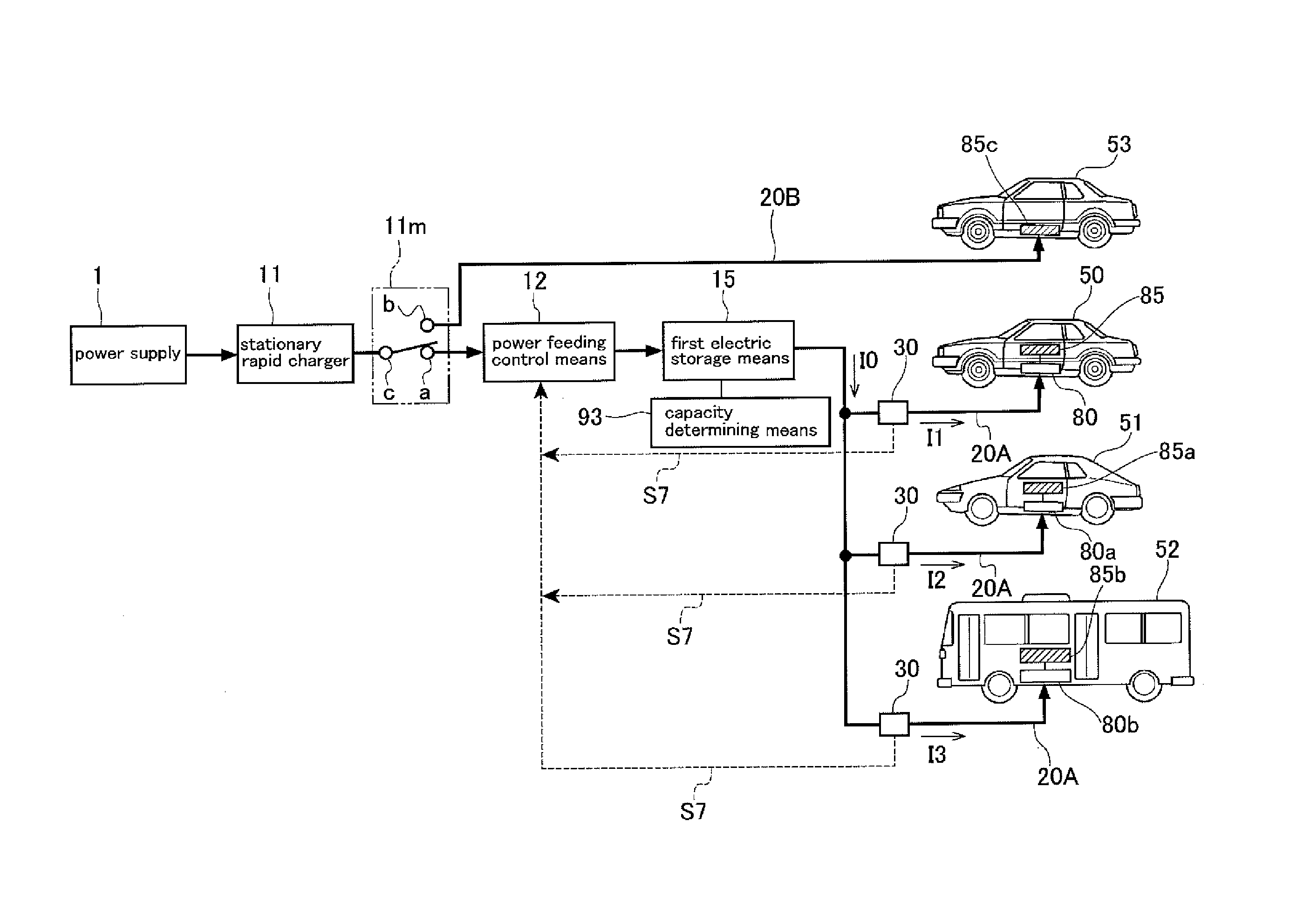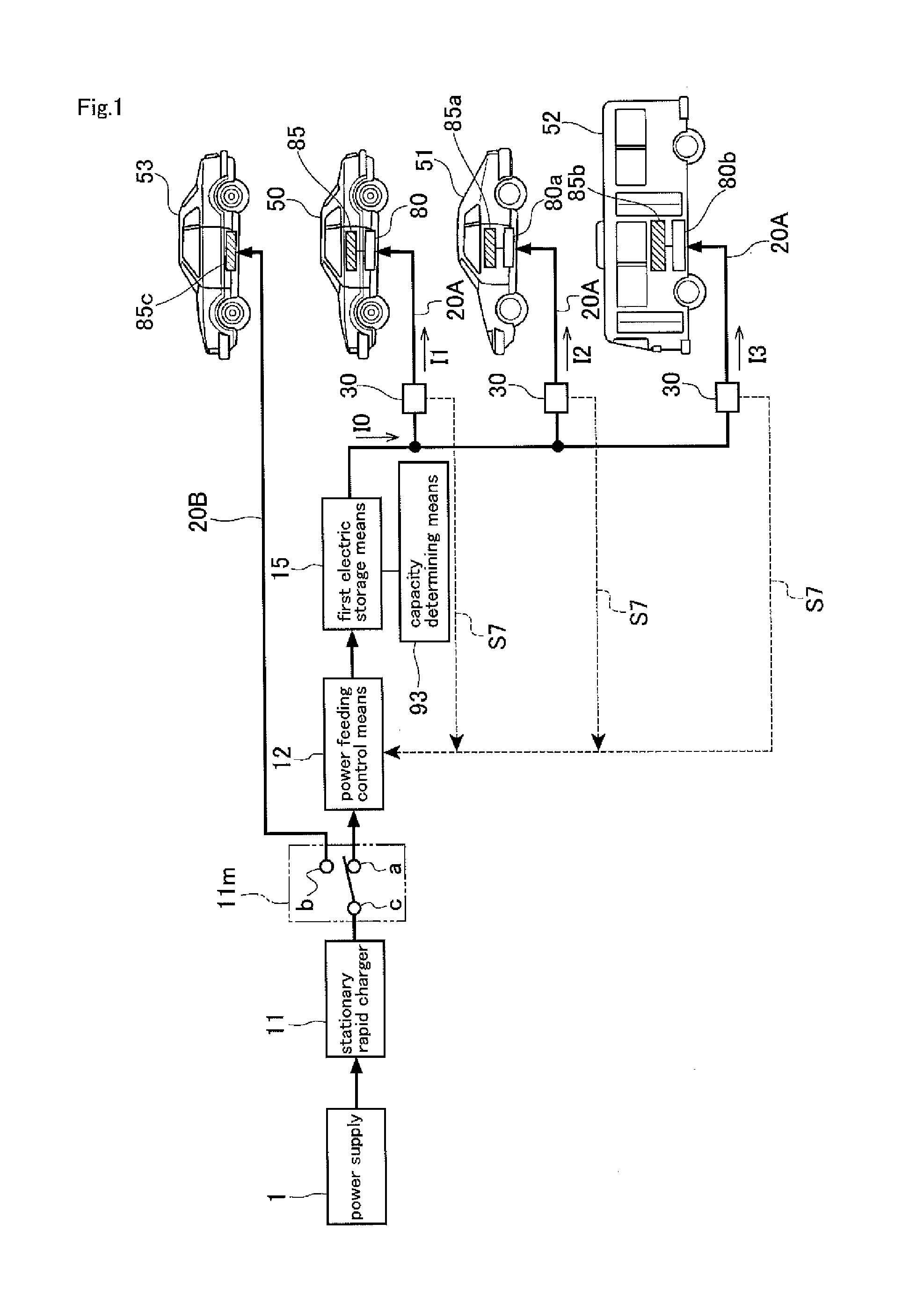Rapid charging power supply system
a power supply system and rapid charging technology, applied in the direction of battery/fuel cell control arrangement, secondary cell servicing/maintenance, capacitor propulsion, etc., can solve the problems of long low operation rate, and electric vehicles corresponding to the charging method according to patent literature 2 are not equipped with rapid charging control means, etc., to improve the utilization efficiency of charging facilities, shorten the waiting time for charging, and the effect of length
- Summary
- Abstract
- Description
- Claims
- Application Information
AI Technical Summary
Benefits of technology
Problems solved by technology
Method used
Image
Examples
embodiment 1
[0046]FIGS. 1 to 10 show Embodiment 1 according to the present invention. In FIG. 2, reference numeral 1 indicates a commercial AC power supply as a power source, and a three-phase AC power supply, for example, is used as an AC power supply 1. Power from the AC power supply 1 is supplied into a building 3 through an electric power line 2. Within the building 3, there are a stationary rapid charger 11, a power supply switching means 11m, a power feeding control means 12, a first electric storage means 15 functioning as a stationary electric storage means, and other devices, which constitute a rapid charging power supply system 10. The input side of the stationary rapid charger 11 is connected to the electric power line 2 within the building 3. The stationary rapid charger 11 has a function of regulating three-phase AC power from the electric power line 2 to a predetermined voltage value, and converting it into DC power.
[0047]The output side of the stationary rapid charger 11 is conne...
embodiment 2
[0085]FIG. 11 shows Embodiment 2 according to the present invention, showing a case of application for rapid charging of both a vehicle and a ship which function as electric moving bodies. The difference in Embodiment 2 from Embodiment 1 is the difference in the type of the electric moving bodies, and the remaining parts correspond to Embodiment 1. Accordingly, the same reference numerals as those in Embodiment 1 are denoted for the corresponding parts, thus omitting the description with respect to the corresponding parts. The same applies to other embodiments to be described below.
[0086]As shown in FIG. 11, the respective charging circuits 20A, connected in parallel with the first electric storage means 15, are connected with a vehicle 50, an electric boat 100, and a passenger ship 101. Electric power for rapid charging is suppliable to the second electric storage means 85 of the vehicle 50, to the second electric storage means 85d of the electric boat 100, and to the second electr...
embodiment 3
[0087]FIG. 12 shows Embodiment 3 according to the present invention, showing an alternate embodiment of Embodiment 1. A wind power generator 5 or a solar cell 6 is excellent for environment since such generation does not produce CO2 during the generation of electric power. However, such wind power generation and solar power generation are susceptible to weather, and the output is greatly varied, thus having a problem of being difficult to be in cooperation with electric power systems. In Embodiment 3, electric power from a wind power generator 5 or a solar cell 6 with large output variation is stored in a first electric storage means 15 functioning as a stationary electric storage means, and the stored electric power is used to perform rapid charging on vehicle 50. With regard to the first electric storage means 15, it is desirable to select a most suitable type in consideration of the fact that electric power supplied will greatly vary. Furthermore, as shown in FIG. 12, it is also ...
PUM
 Login to View More
Login to View More Abstract
Description
Claims
Application Information
 Login to View More
Login to View More - R&D
- Intellectual Property
- Life Sciences
- Materials
- Tech Scout
- Unparalleled Data Quality
- Higher Quality Content
- 60% Fewer Hallucinations
Browse by: Latest US Patents, China's latest patents, Technical Efficacy Thesaurus, Application Domain, Technology Topic, Popular Technical Reports.
© 2025 PatSnap. All rights reserved.Legal|Privacy policy|Modern Slavery Act Transparency Statement|Sitemap|About US| Contact US: help@patsnap.com



